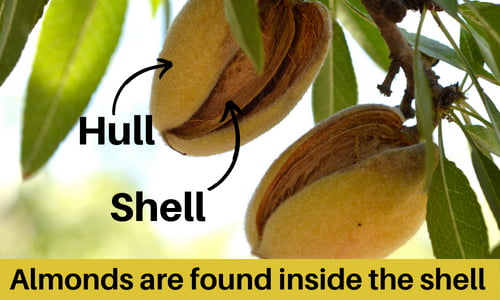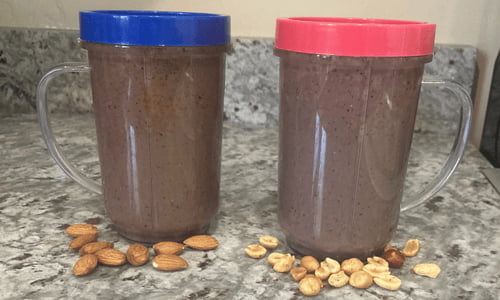Almond Butter vs. Peanut Butter
“Almond Butter vs. Peanut Butter” was written by Amanda Crowe, MS, RDN, CD & edited/reviewed by Aly Bouzek, MS, RDN.
What’s the Difference Between Almond Butter vs. Peanut Butter?

Almonds are a tree nut that are found inside a drupe’s (or stone fruit’s) hull and outer shell layers.
Once the almond is removed from these layers, it can be eaten.
Peanuts are considered a legume.
The peanut plant grows and blossoms above ground while the fruit itself grows underground.
Once almonds and peanuts are harvested, they are safe for eating. However, they are both cleaned and processed before hitting the store shelves where you can find them for purchase.
How Are They Made?
Almonds are shelled, roasted, and milled. Then, other ingredients are added like salt, hydrogenated oil, or flavorings to create almond butter. The almond butter is stirred one more time, bottled, sealed, and is then ready for store shelves.
Peanuts are shelled, roasted, blanched, skinned, separated, and ground up. Then, any ingredients like salt, sugar, hydrogenated oil, and/or flavorings are added to make peanut butter.
The peanut butter is given a final stir, bottled, sealed, and then is ready to hit the stores.
Nutrition Information
Many almond butters and peanut butters have salt, sugar, or hydrogenated oil added to them. Hydrogenated oil is added to prevent the separation of the nuts and oil.
Almond butter and peanut butter are also sold without hydrogenated oil, they just need to be stirred before eating.
When choosing an almond butter or a peanut butter look for natural varieties that do not contain added sugar, fat, and have limited salt. Fresh almond or peanut butter can be made at some local stores.
The following is a matchup of 2 tablespoons (1 serving) of almond butter vs. peanut butter. The numbers will vary slightly based on the kind and brand of almond butter or peanut butter chosen.
| Almond Butter (1) | Peanut Butter (2) | |
| Calories | 196 | 191 |
| Protein | 6.7 gm | 7.2 gm |
| Carbohydrate | 6 gm | 7 gm |
| Fat | 17.8 gm | 16.4 gm |
| Saturated Fat | 2 gm | 3.2 gm |
| Monounsaturated Fat | 10.4 gm | 8.1 gm |
| Polyunsaturated Fat | 4.4 gm | 3.9 gm |
| Fiber | 3.3 gm | 1.5 gm |
| Sugar | 2 gm | 3.4 gm |
| Calcium | 55 mg | 16 mg |
| Iron | 1 mg | 0.6 mg |
| Vitamin E | 7.7 mg | 3 mg |
| Potassium | 240 mg | 180 mg |
| Magnesium | 89 mg | 54 mg |
| Zinc | 1 mg | 0.8 mg |
| Selenium | 0.8 µg | 1.3 µg |
| Vitamin B6 | 0.03 µg | 0.14 µg |
Final Nutrient Breakdown
Almond butter and peanut butter are both yummy options.
- Almond butter, however, has more vitamins and minerals than peanut butter.
- So if you’re looking for ways to increase your calcium, iron, potassium, magnesium, or vitamin E, then almond butter would be a better choice.
- Almond butter and peanut butter are similar in calories, protein, carbohydrate, and fat.
When eating these products, it is important to watch serving sizes because they are a low volume high calorie food (unless you are trying to gain weight, then by all means add another scoop!).
Cost
The cost of almond butter is higher because the cost of almonds, in general, is more than the cost of peanuts. Almond butter can range in price from $0.36 – $1.57 per ounce versus peanut butter’s price range of $0.13 – $1.03 per ounce.
Even though almond butter is more expensive than peanut butter, both can be considered a cheap source of protein for those on a budget.
Buying nuts in bulk and making your own almond butter or peanut butter in a blender is one way to bring down the cost per serving.
Eating Almond Butter vs. Peanut Butter
If you’re allergic to almonds or peanuts, then avoid eating them. When cooking, use peanut butter instead of almond butter if you have a tree nut allergy. And if you have a peanut allergy, choose almond butter instead of peanut butter.
A 1:1 ratio can be used when swapping the nut butters during cooking.
Snacks with Almond Butter vs. Peanut Butter
Almond butter and peanut butter both make snack time delicious and fun! They are also helpful because their protein gives you long term energy and their fat helps you feel full or satisfied after eating.
Try these delicious snacks!

- Apples with almond butter or peanut butter
- Celery with almond butter or peanut butter, add raisins to make ants on a log
- Banana with a spoonful of almond butter or peanut butter
- Individual servings of almond butter or peanut butter can be used as an on-the-go snack
- Almond butter or peanut butter protein bars
- Almond butter or peanut butter can be used in no-bake cookies. Here is a recipe from our sister site, High Calorie Recipes, for No-Bake Peanut Butter Balls.
On a side note, almond butter and peanut butter have both been turned into powders as well. This can make them easier to add to a smoothie, put in a homemade protein bar, or to add to your no-bake cookies.
Meals with Almond Butter vs. Peanut Butter
Almond butter or peanut butter can help meals come together quickly while adding a cheap source of protein. Peanut butter can be used in a dish, as a topping, or can be used to create a side dish or dessert.
Here are some ideas:
- Almond butter or peanut butter can be added to smoothies and shakes
Check out these yummy recipes from High Calorie Recipes for a Peanut Butter Banana Smoothie and an Almond Butter Weight Gain Shake.
- Add either of the nut butters to oatmeal
- Almond butter or peanut butter can be put on top of pancakes, waffles, or crepes
- Spread peanut butter or almond butter with jelly to make a sandwich
- Add peanut butter or almond butter to savory dishes like Thai peanut chicken or pad Thai
- Add either nut butter to cookies

Conclusion
Almond butter has more vitamins and minerals but both almond butter and peanut butter can make a healthy, budget friendly addition to your diet.
Whether added to a breakfast smoothie, used for on-the-go snacking, or making an appearance in your evening meal, these nut butters can be used whenever you need a boost of protein and nutrients!
Since almond butter and peanut butter are similar in nutrition, health benefits, and both come in creamy or crunchy/chunky, pick the one that you enjoy the most, or add variety in your diet and try them all!
Which nut butter is your favorite?
Resources:
- Almond Butter. FoodData Central. https://fdc.nal.usda.gov/fdc-app.html#/food-details/1100555/nutrients.
- Peanut Butter. FoodData Central. https://fdc.nal.usda.gov/fdc-app.html#/food-details/1100559/nutrients.
